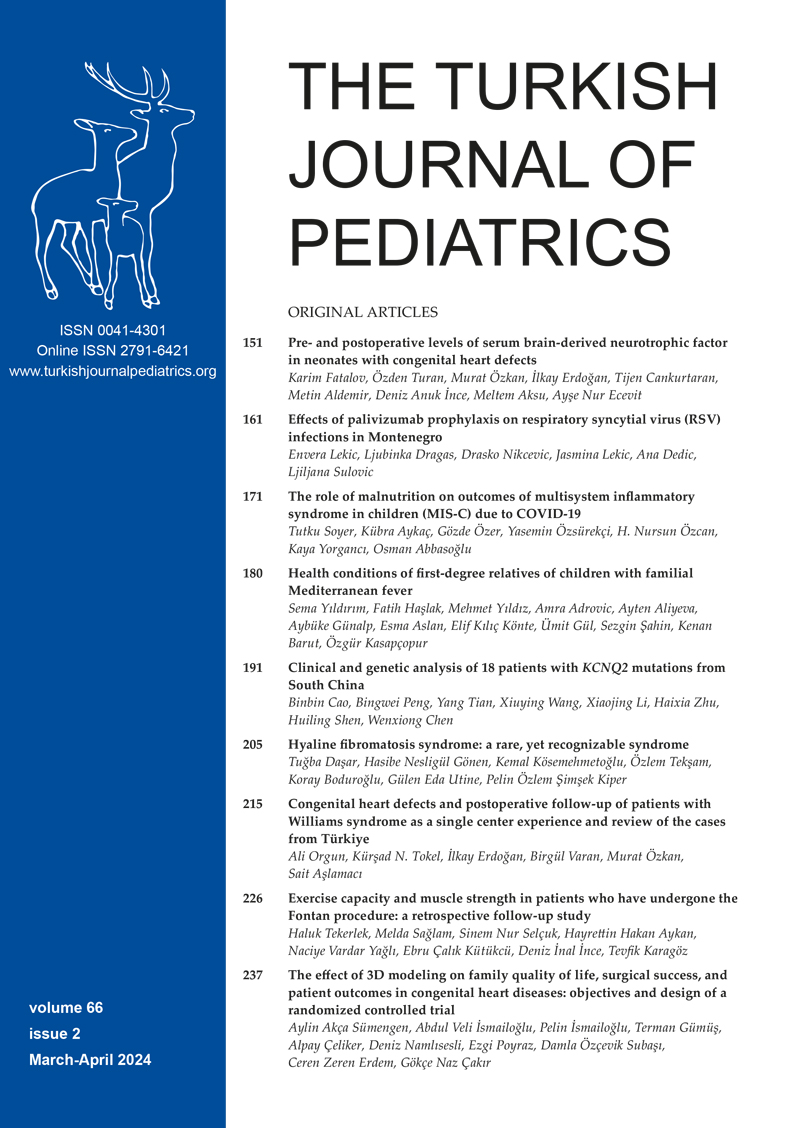Abstract
Background. Malnutrition increases the complications and mortality in critically-ill children. We performed a retrospective analysis to define the impact of malnutrition on the outcomes of multisystem inflammatory syndrome in children (MIS-C) due to COVID-19.
Methods. Patients with MIS-C were evaluated for demographic features, anthropometric parameters, clinical findings and outcomes. Patients with z scores of body mass index (> 5 years) and weight-for-age (< 5 years) < -2 were considered malnourished. Sarcopenia was defined by total psoas muscle area (tPMA), calculated on abdominal computed tomography (CT) at the level of L3 and L4 vertebrae. The z scores <- 2 for tPMA were considered sarcopenia. The results of patients with and without malnutrition were compared.
Results. Twenty-seven patients were included. Forty-four percent (n=12) of patients had malnutrition. Malnutrition was classified as mild to moderate (1/3), severe (1/3) and overweight (1/3). Eighty-two % of cases had acute malnutrition. Among MIS-C symptom criteria, rash was significantly higher in children with malnutrition (p<0.05). Laboratory investigations showed higher ferritin levels in patients with malnutrition (p<0.05). The median tPMA and sarcopenia were significantly higher in patients with malnutrition when compared to patients without malnutrition (42% vs 7%, p<0.05). The oral feeding time, complication rates, and length of hospital stay were similar in both groups (p>0.05).
Conclusion. Children with MIS-C already had mild to severe malnutrition at admission. Rash and higher ferritin levels were more common in patients with malnutrition. In addition to anthropometric parameters, sarcopenia calculated using tPMA can be used to predict malnutrition in critically-ill children.
Keywords: malnutrition, COVID-19, multisystem inflammatory syndrome, sarcopenia
References
- Barazzoni R, Bischoff SC, Breda J, et al. ESPEN expert statements and practical guidance for nutritional management of individuals with SARS-CoV-2 infection. Clin Nutr 2020; 39: 1631-1638. https://doi.org/10.1016/j.clnu.2020.03.022
- Bedock D, Bel Lassen P, Mathian A, et al. Prevalence and severity of malnutrition in hospitalized COVID-19 patients. Clin Nutr ESPEN 2020; 40: 214-219. https://doi.org/10.1016/j.clnesp.2020.09.018
- Kurtz A, Grant K, Marano R, et al. Long-term effects of malnutrition on severity of COVID-19. Sci Rep 2021; 11: 14974. https://doi.org/10.1038/s41598-021-94138-z
- Gregoriano C, Voelkle M, Koch D, et al. Association of different malnutrition parameters and clinical outcomes among COVID-19 patients: an observational study. Nutrients 2022; 14: 3449. https://doi.org/10.3390/nu14163449
- McArdle AJ, Vito O, Patel H, et al. Treatment of multisystem inflammatory syndrome in children. N Engl J Med 2021; 385: 11-22. https://doi.org/10.1056/NEJMoa2102968
- Di Profio E, Leone A, Vizzuso S, et al. Longitudinal anthropometry and body composition in children with SARS-CoV-2-associated multisystem inflammatory syndrome. J Pediatr Gastroenterol Nutr 2023; 76: 505-511. https://doi.org/10.1097/MPG.0000000000003705
- Ooi PH, Thompson-Hodgetts S, Pritchard-Wiart L, Gilmour SM, Mager DR. Pediatric sarcopenia: a paradigm in the overall definition of malnutrition in children? JPEN J Parenter Enteral Nutr 2020; 44: 407-418. https://doi.org/10.1002/jpen.1681
- Lurz E, Patel H, Lebovic G, et al. Paediatric reference values for total psoas muscle area. J Cachexia Sarcopenia Muscle 2020; 11: 405-414. https://doi.org/10.1002/jcsm.12514
- Centers for Disease Control and Prevention (CDC). Information for healthcare providers about multisystem inflammatory syndrome in children (MIS-C). 2021. Available at: https://www.cdc.gov/mis/mis-c/hcp/index.html (Accessed on July 21, 2022).
- Neyzi O, Bundak R, Gökçay G, et al. Reference values for weight, height, head circumference, and body mass index in Turkish children. J Clin Res Pediatr Endocrinol 2015; 7: 280-293. https://doi.org/10.4274/jcrpe.2183
- World Health Organization (WHO), United Nations Children’s Fund (UNICEF). WHO child growth standards and the identification of severe acute malnutrition in infants and children: a joint statement. Geneva, Switzerland: WHO and UNICEF; 2009. Available at: https://iris.who.int/bitstream/handle/10665/44129/9789241598163_eng.pdf
- Ritz A, Froeba-Pohl A, Kolorz J, et al. Total psoas muscle area as a marker for sarcopenia is related to outcome in children with neuroblastoma. Front Surg 2021; 8: 718184. https://doi.org/10.3389/fsurg.2021.718184
- Ventura JC, Hauschild DB, Barbosa E, et al. Undernutrition at PICU admission is predictor of 60-day mortality and PICU length of stay in critically ill children. J Acad Nutr Diet 2020; 120: 219-229. https://doi.org/10.1016/j.jand.2019.06.250
- Chapple LS, Tatucu-Babet OA, Lambell KJ, Fetterplace K, Ridley EJ. Nutrition guidelines for critically ill adults admitted with COVID-19: is there consensus? Clin Nutr ESPEN 2021; 44: 69-77. https://doi.org/10.1016/j.clnesp.2021.05.003
- Rekhtman S, Tannenbaum R, Strunk A, Birabaharan M, Wright S, Garg A. Mucocutaneous disease and related clinical characteristics in hospitalized children and adolescents with COVID-19 and multisystem inflammatory syndrome in children. J Am Acad Dermatol 2021; 84: 408-414. https://doi.org/10.1016/j.jaad.2020.10.060
- Zhao Y, Yin L, Patel J, Tang L, Huang Y. The inflammatory markers of multisystem inflammatory syndrome in children (MIS-C) and adolescents associated with COVID-19: a meta-analysis. J Med Virol 2021; 93: 4358-4369. https://doi.org/10.1002/jmv.26951
Copyright and license
Copyright © 2024 The Author(s). This is an open access article distributed under the Creative Commons Attribution License (CC BY), which permits unrestricted use, distribution, and reproduction in any medium or format, provided the original work is properly cited.















